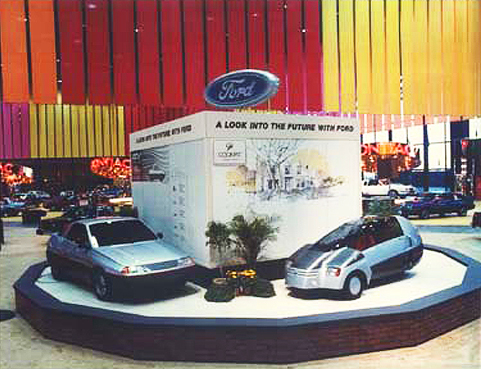
Much like auto shows of 2012, this 1982 Ford display touts electric cars as “the future”.
Attending this year’s New York auto show press preview April 4-5, we heard alot about fuel economy, four-cylinder engines giving performance of V8s, diesel engines, hybrid electric cars, lighter vehicle platforms, and front-wheel-drive.
Those, like us, old enough to remember 30 years ago began to notice this all sounded very similar to what the auto industry was pitching back in 1982 in answer to a similar 3-year span of high gas prices, weak national economic conditions, and impending government fuel economy regulations. There were even DeLoreans and Fiats on the show floor this year, something else that hadn’t occurred since 1982.
Looking at opening passages from an official 1982 New York auto show booklet, one reads…
“The scientific, engineering and styling advances that are ‘in’ for 1982 include cars with greater fuel economy than ever before, and with more ingenious electronics and on-board computers controlling operating performance. They are also endowed with new and better powerplants, with front-wheel-drive for improved handling and increased interior passenger room. They are made of new lighter weight and stronger structural materials, along with sleeker aerodynamic styling which also boosts operating efficiency”
Half a decade ago at shows, manufacturers talked about how they had managed to fit 6-cylinder engines in a space where 4-cylinders normally dwelled. 8-cylinders where 6-cylinders normally dwelled. And finally in some cases, 10- or 12-cylinder engines. The race for brute horsepower was on.
Today, seeing large, heavier Chevy Impala, Lincoln MKZ, Ford Explorer, and Range Rover models being introduced with four-cylinder engines, one realizes this is quite the reverse of recent years past. So we took a closer look back at 1982…
SOME FACTS ABOUT 1982 AUTOMOTIVE TRENDS AT THAT YEAR’S NEW YORK AUTO SHOW:
FRONT-WHEEL-DRIVE 4-CYLINDERS
According to the 1982 auto show booklet, “The trend towards front-wheel-drive is in motion because it makes possible larger and more efficient cars, and better riding and handling…American Motors goes yet one step further to four-wheel-drive on its Eagle and Eagle SX/4, for even surer control than front-wheel-drive.”
- 1982 was the first year that the number-one selling car in America (Ford Escort) was front-wheel-drive and had no engine options larger than a 4-cylinder. Except for the following year (’83 Oldsmobile Cutlass Supreme), best-selling cars would be front-wheel-drive and offer 4-cylinders.
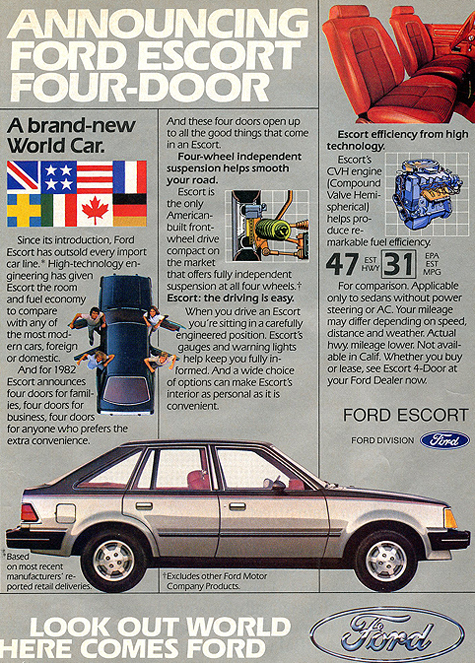
1982 Ford Escort ad (photo credit: Ford Motor Company)
- 4-cylinder engines were suddenly available where they had not been before: in 6-passenger family cars and sports cars. The downsized, front-wheel-drive Chrysler LeBaron and (slighly longer) New Yorker weighed some 700+ pounds less than their forebearers and featured only 4-cylinder engines through the rest of the 1980s.
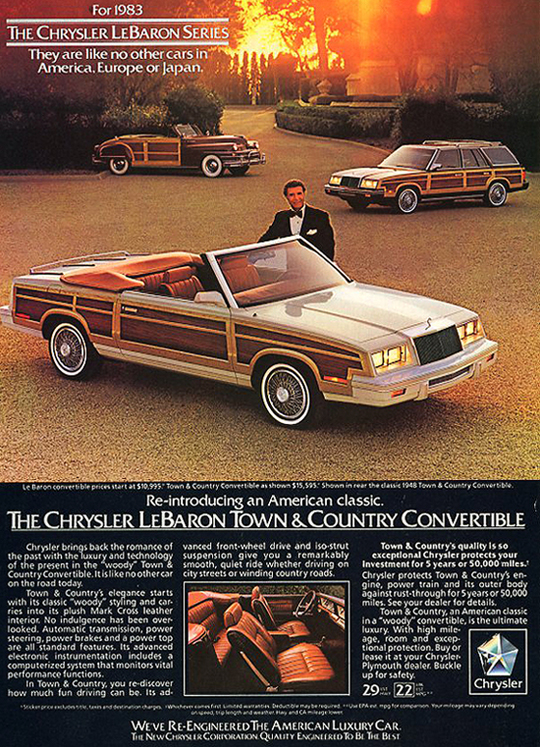
Before 1982, Chrysler LeBarons were always large, V8-powered, and rear-wheel-drive. New ones introduced in this ad (1983 shown) were small cars with 4-cylinder turbos. Photo credit: Chrysler Corporation
- The new-for-’82 Buick Century, Chevrolet Celebrity, and Olds Ciera were midsize cars on a front-wheel-drive platform offering 4-cylinders. All were approximately 600 pounds lighter than rear-wheel-drive ’81 models they were designed to replace.
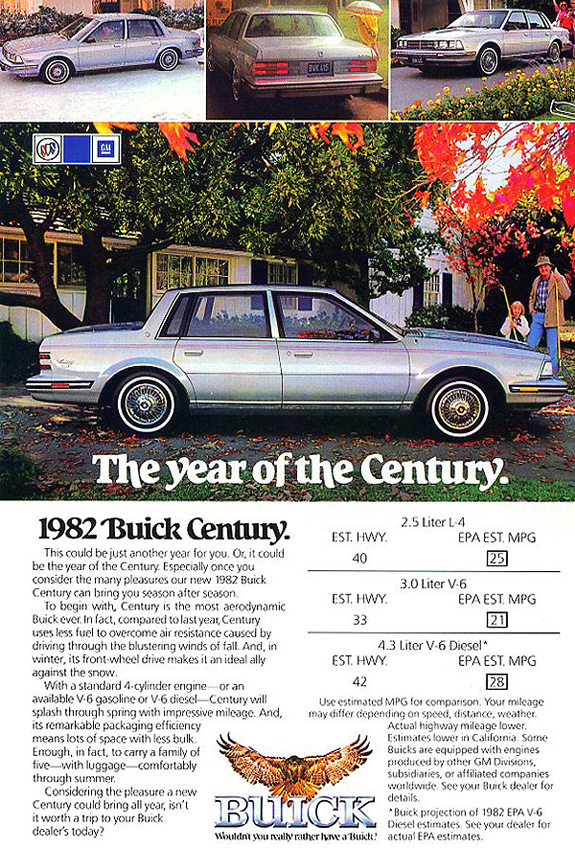
Today, Buick introduces smaller-than-usual models such as the Verano, Encore, and Regal focusing on 4-cylinder economy. In 1982, it was this new Century model. (Photo credit: General Motors Corporation)
- Even the downsized-for-’82 Chevrolet Camaro featured a 2.5-liter 4-cylinder as its base engine choice. Because the new Camaro was some 400 pounds lighter than the previous 1970-81 style, 4-cylinder performance was about the same as the old model with a larger V6. Quite a number of 4-cylinder Camaros were sold through 1986.

4-cylinder engines were offered in Chevrolet Camaros from 1982-86 (1982 model shown). Photo credit: S. Palmer
4-CYLINDER TURBO ENGINES
- As popular as they grew to become in the 1980s, only Saab was selling them in the United States (since 1979) on ’82 models. 4-cylinder turbo engines were big news at the ’82 auto show, and would very soon be making appearances on upcoming 1983 Subarus, 1983 Mitsubishis, 1983 Ford Mustang & Thunderbird SVT editions, 1984 Buick Skyhawks/Pontiac Sunbirds, most 1984 Chrysler company front-wheel-drive vehicles, and on 1984 Nissan Pulsars & 200SXs.
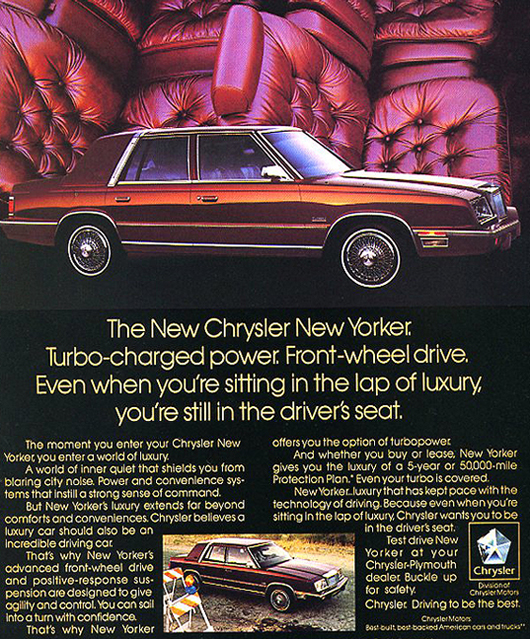
This Chrysler New Yorker ad similarly represents auto industry focus (then and now) on luxury models with turbo engines a fraction of earlier sizes. (Photo credit: Chrysler Corporation)
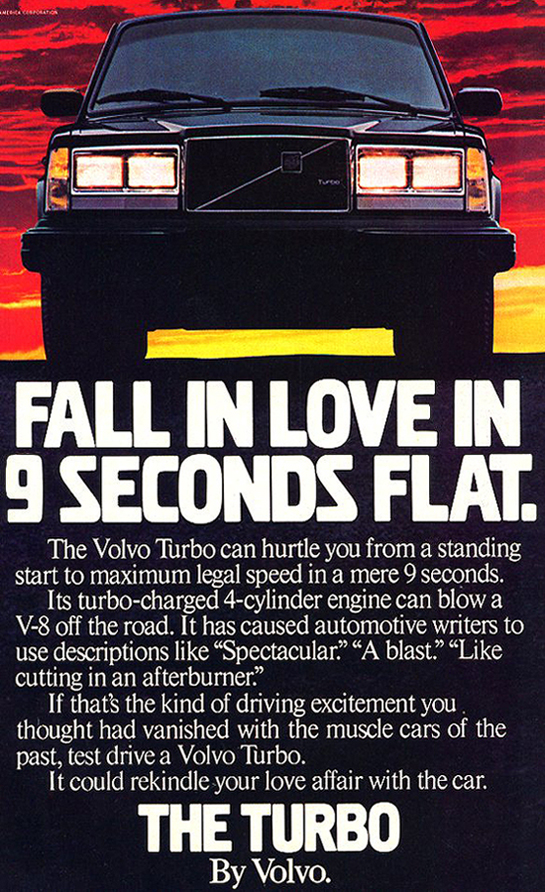
Much like promotional material from many automakers at the auto show this year, this 1982 Volvo Turbo ad speaks of 4-clyinder turbos making V8 engines obsolete. (Photo credit: Volvo Cars North America)
Today: 2013 Ford Explorer and Taurus models are front-wheel-drive based, with all-wheel-drive as an option. Powertrain choices on both are a 2.0-liter turbo 4-cylinder making 240 horsepower, or 3.5-liter V6 making 290 horsepower. V8 engines from last year’s Explorer, and previous Taurus SHOs are gone. For more info, see http://www.ford.com/?searchid=35041264|1184031124|
Similarly, the new-for-2013 Lincoln MKZ is a large, front-wheel-drive sedan replacing the rear-wheel-drive, V8-powered Town Car. Engine choices are a 2.0-liter 4-cylinder hybrid engine making 188 horsepower, a 2.0-liter turbo 4-cylinder making 240 horsepower, or 3.7-liter V6 producing 300 horsepower. All-wheel-drive is optional. For more info, see Lincoln’s website http://www.lincoln.com/cars/mkz/2013/
SMALLER ENGINES ALL AROUND.
Cars that hadn’t yet switched to front-wheel-drive were coming with smaller engines for the first time too.
- For the first time ever, a 4.1-liter V6 engine was available in full-size Cadillacs during 1981-82, phasing it out after introducing a new 4.1-liter V8 engine as the only eight-cylinder engine choice in all models for 1982. Versions of the V6 were also available in full-size Chevrolet Caprice/Impala and Buick LeSabre/Electra sister cars.
- The Ford Granada midsize sedan of 1981-82 was 300 pounds lighter than the previous 1975-80 generation. For the first time, a 4-cylinder was the base engine choice. A V8 was still optional, but the size had dropped from 5.0 to 4.2 liters. This 4.2-liter was also now offered in the full-size Ford LTD also.
- Similarly, a smallest-ever Chevrolet 4.4-liter V8 had been in use for several years on Caprices, Impalas, Monte Carlos, and 1980-81 Camaros.
- Lincoln introduces it’s smallest ever Continental for 1982, with a V6 offered for the first time in any Lincoln.
Today: The new-for-2014 Chevy Impala offers a 182 horsepower 2.4-liter 4-cylinder hybrid electric engine with integrated stop/start, a 195 horsepower 2.5-liter 4-cylinder, and 303 horsepower 3.6-liter V6 engine choices. Gone is the V8-powered SS model. For more info, see http://www.chevrolet.com/culture/article/2014-impala-sports-sedan/
Replacing the V8-powered Cadillac DTS is a new-for-2013 XTS front-wheel-drive sedan. The sole powerplant is a 3.6-liter V6 engine producing 303 horsepower from the Chevy Impala. For more info, see Cadillac’s website http://bit.ly/HqFGvZ
As well, over the last three years, Audi and Volkswagen have systematically dropped the cylinder count on A3, A4, S4, A6, S6, A5, S5, Touareg and Passat models.
DIESEL ENGINES
- A passage from the 1982 New York auto show book reads “Diesel engines are rapidly expanding in American cars because of their economy and simple maintenance requirements.”
- New passenger car diesel entries for 1982 being touted at the show were the Chevrolet Chevette and Citation (4-cylinder diesels); Volvo 240 (4-cyl); Audi 4000 (4-cyl); Chevrolet Celebrity, Malibue, and Monte Carlo (V6s); Buick Riviera, Century, and Regal (V6s); Olds Ciera and Cutlass Supreme (V6s).

This 1982 GM ad in the New York Auto show booklet emphasizes new company focus on smaller engines, lighter weight cars, and diesels. Much like the industry now. Photo credit: General Motors Corporation
- Those above joined already other existing diesel offerings from Mercedes-Benz, General Motors, Volkswagen, and Peugeot.
- As well, diesel engines would soon be offered on 1984-85 Mazda 626s, 1984-85 Lincoln Continentals, 1984-85, 1984-87 Ford Escorts, 1984-86, Ford Tempos, 1984-86 Toyota Camrys, 1984-85 Toyota Corolla fwd, and on 1985-86 BMW 5-series.
- Ford was even readying a 4-cylinder propane engine which was offered on production 1983-84 midsize LTDs!
Today: Diesel engines with clean-emissions technology are featured at the show on new BMW, Audi, Volkswagen, Mercedes, Porsche models as well as on large Dodge, Ford and Chevrolet pickup trucks and sport utilities.
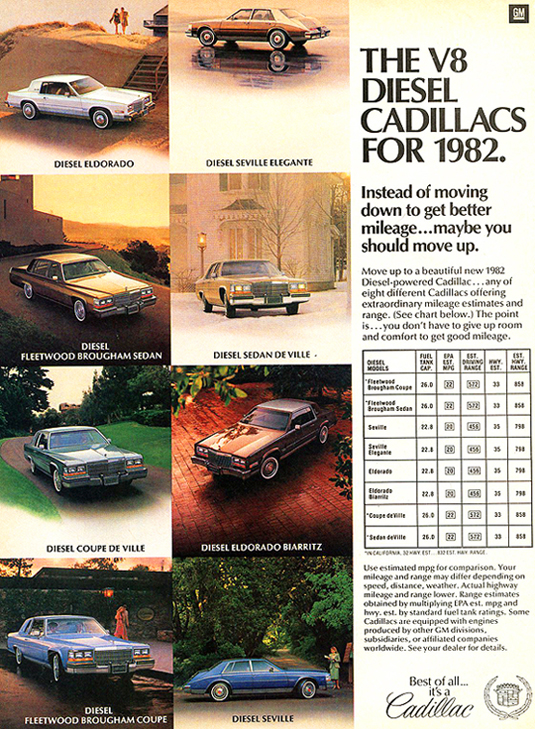
Similar to product literature at the 2012 auto show, this 1982 Cadillac ad introduces a strong focus on fuel economy on its largest of car models. (Photo credit: General Motors)
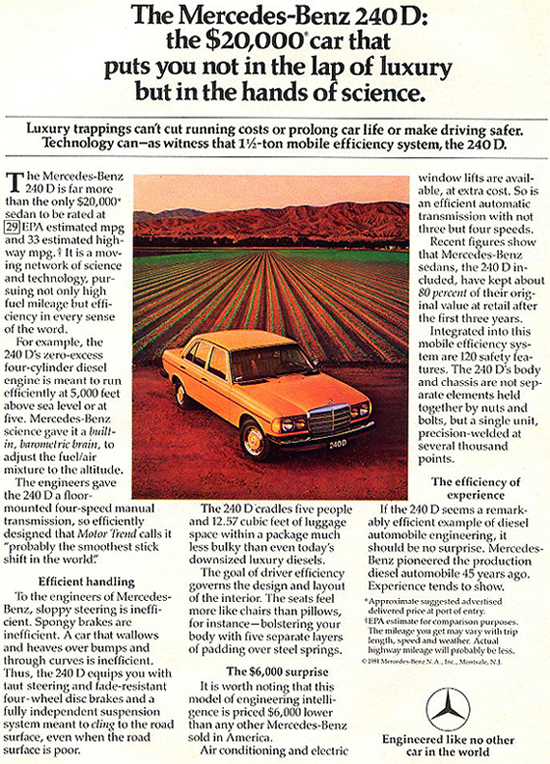
In 1982, 80% of Mercedes-Benzes sold in the US were diesels. All German automakers are bringing more diesel models back to our market today. Photo credit: Daimler-Benz
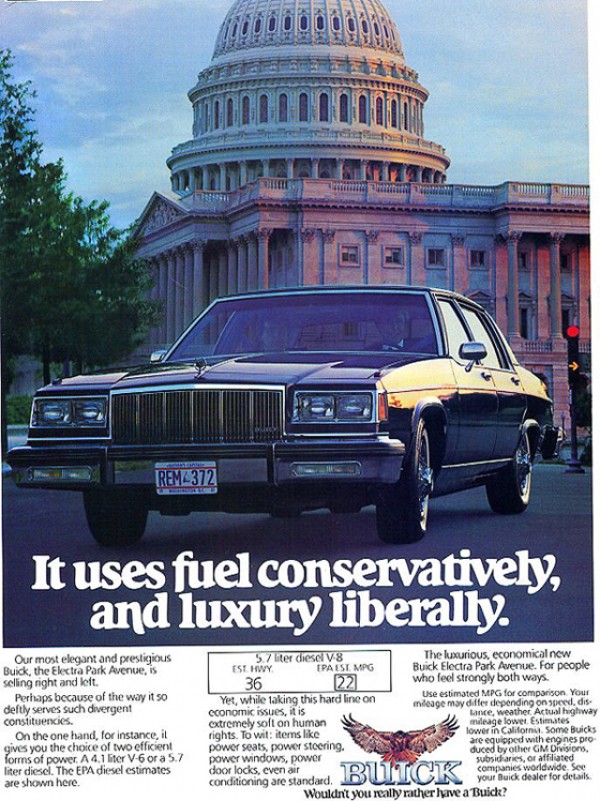
If you have any doubts the auto industry was not singing the same song as today, this 1982 Buick full-size Electra Diesel ad will convince you. (Photo credit: General Motors)
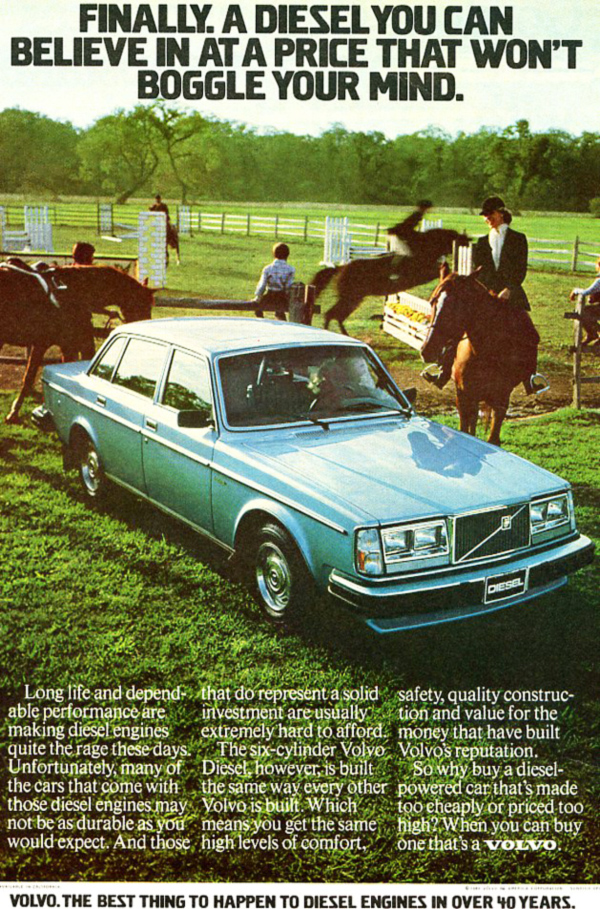
Much like today, many European brands had a new focus on bringing diesel engine technology to the United States. (Photo credit: Volvo Cars North America)
DELOREANS
According to the 1982 New York show pamphlet, “From the moment of its first public appearance the DeLorean sports car has been a design success. Its carefully crafted lines, from the pen of Ital Design’s Giurgiaro, broke new ground in the world of high performance automobiles. But there’s more to the DeLorean than sleek Italian styling, sweeping expanses of glass, and lustrous stainless steel…”
- 1982 was the first and only New York auto show the DeLorean Motor Company DMC-12 gullwing coupe of 1981-82 made an appearance before the company declared bankruptcy December 1982. Originally featuring a 2.8-liter V6 engine making 141 horsepower, Road & Track magazine commented “It’s not a barn burner with a 0-60 mph time of 10.5 seconds. Frankly, that’s not quick for a sports/GT car in this price category.”
- In 1995, Englishman Stephen Wynne started a separate company using the DeLorean Motor Company name and shortly thereafter acquired the remaining parts inventory and stylized “DMC” logo trademark. Primarily, his business was supplying the repair industry with parts needed to maintain original DMC12s.
Today in the basement level of this year’s 2012 show is a display by Mr. Wynne’s DeLorean Motor Company detailing their production of new vehicles with original-spec body parts. Power will no longer be from gasoline engines, but solely from electric motors running off battery packs. For more details, see http://delorean.com/

The DeLorean DMC-12 makes a debut at the 1982 New York auto show…one of many similarities to today’s show 30 years later. Photo credit: Jack Panance
SIMILARITIES TO 30 YEARS PAST ARE ACTUALLY A GOOD THING
As the early-’80s became the mid-’80s, fuel prices stabilized, economic conditions picked up, and government regulations mandating stricter fuel economy regulations were put on hold. It didn’t take long for engine size, vehicle size, and horsepower numbers to grow larger again across the board.
At the press preview, we heard auto executive after auto executive speaking optimistically about recent sales improvements and return to profitability. (It seems the bottom of the market that fell out three years ago has been located and re-secured). About how focusing on giving the customer as refined an automotive experience as possible is important – no, essential, in not being left behind by competitors.
Developing battery technology isn’t talk – today, every automotive nameplate already has hybrid models on the market that use electric motors and battery packs to work hand-in-hand with small-displacement gas engines. Momentum of being in bulk production tends to drive costs down, and the drive to cut costs will fund the means and will to research real improvements that would never happen otherwise. The same goes for using lighter weight but expensive materials like aluminum and carbon fiber. They’re actually doing it more.
And car makers are actually focusing on making the customer happy by funding construction of modern dealership facilities, and rewarding the ones much more who perform in customer satisfaction surveys.
So we feel their optimism was sincere and backed up with proof.
Fans of V8 engines, rest assured they will never go out of style no matter what pundits predict. There just won’t be as many of them. But one thing’s for sure – better V8 engines have always resulted from lessons learned in the past building the best 4-cylinder engines. 500+ horsepower Mustangs, Camaros, AMG Mercedes-Benzes and many others today wouldn’t exist without hardships faced in 1982.
It’s a good time to be a car enthusiast, and a great time to embrace new technology and the improvements coming on tomorrow’s vehicles. We look forward to seeing what a V8 engine can do in 2020…
-Sean
 1969 Volkswagen Karmann Ghia wheelPhoto: Genna Rae
1969 Volkswagen Karmann Ghia wheelPhoto: Genna Rae 1969 Volkswagen Karmann GhiaPhoto: Genna Rae
1969 Volkswagen Karmann GhiaPhoto: Genna Rae 50s Calnevar aftermarket hubcaps shPhoto credit: T. Gorski
50s Calnevar aftermarket hubcaps shPhoto credit: T. Gorski Chrysler LeBaron Town & Country wheel cover
Chrysler LeBaron Town & Country wheel cover Cadillac Eldorado painted wheel cover 1976-78Photo: Nate Smith
Cadillac Eldorado painted wheel cover 1976-78Photo: Nate Smith 1974 - 1976 Lincoln Continental wheel coverPhoto credit: H. Carver
1974 - 1976 Lincoln Continental wheel coverPhoto credit: H. Carver 1969 Oldsmobile Cutlass Supreme rallye wheelPhoto: C. DeMarco
1969 Oldsmobile Cutlass Supreme rallye wheelPhoto: C. DeMarco Chrysler 1980s painted wheel coverPhoto: O. Stein
Chrysler 1980s painted wheel coverPhoto: O. Stein 13-inch General Motors color matched wheel 1975-80Photo: Valley Ride Styles
13-inch General Motors color matched wheel 1975-80Photo: Valley Ride Styles Audi TT RS wheelPhoto: Sean Connor
Audi TT RS wheelPhoto: Sean Connor 1994 - 1995 Mercedes E320 Cabriolet wheel
1994 - 1995 Mercedes E320 Cabriolet wheel 2012 Volkswagen Beetle 2.5 standard wheel
2012 Volkswagen Beetle 2.5 standard wheel 16-inch black steel Land Rover off-road wheelsPhoto credit: J. Getty
16-inch black steel Land Rover off-road wheelsPhoto credit: J. Getty 18-inch aluminum wheel on 2003 - 2004 Land Rover Discovery HSE
18-inch aluminum wheel on 2003 - 2004 Land Rover Discovery HSE 18 inch "Hurricane" aluminum wheel standard on 2002-2004 Discovery SE
18 inch "Hurricane" aluminum wheel standard on 2002-2004 Discovery SE 1957 - 1958 Pontiac wire wheel cover(Photo credit: R. Ulrich)
1957 - 1958 Pontiac wire wheel cover(Photo credit: R. Ulrich) 1972 Mercedes 280SE 4.5 equipped with repro 15-inch alloy wheels(Photo credit: Sean Connor)
1972 Mercedes 280SE 4.5 equipped with repro 15-inch alloy wheels(Photo credit: Sean Connor) 560SL 15-inch aluminum wheel
560SL 15-inch aluminum wheel 1981 Porsche 924 Carrera GT aluminum wheel
1981 Porsche 924 Carrera GT aluminum wheel 1978 Lincoln Mark V DJ blue wheel b(Photo credit: M. Garrett)
1978 Lincoln Mark V DJ blue wheel b(Photo credit: M. Garrett) 1979 Lincoln Mark V Collectors Series navy blue painted wheel(Photo credit: M. Garrett)
1979 Lincoln Mark V Collectors Series navy blue painted wheel(Photo credit: M. Garrett) 1969 Dodge Charger RT Hemi wheel with center hub cap
1969 Dodge Charger RT Hemi wheel with center hub cap 1953 Oldsmobile wire-wheel
1953 Oldsmobile wire-wheel 2014 Jaguar XK RS GT wheel at the 2013 New York Auto Show(Photo credit: Sean Connor)
2014 Jaguar XK RS GT wheel at the 2013 New York Auto Show(Photo credit: Sean Connor) 2014 Mercedes CLA45 AMG wheel at the 2013 New York Auto Show(Photo credit: Sean Connor)
2014 Mercedes CLA45 AMG wheel at the 2013 New York Auto Show(Photo credit: Sean Connor) 2013 Subaru WRX concept wheel at the 2013 New York Auto Show
2013 Subaru WRX concept wheel at the 2013 New York Auto Show 1952 Volkswagen wheelPhoto credit: L. Jacobs
1952 Volkswagen wheelPhoto credit: L. Jacobs 1975 Pontiac Grand Ville rallye wheelPhoto credit: Sean Connor
1975 Pontiac Grand Ville rallye wheelPhoto credit: Sean Connor 1991 Cadillac Fleetwood Brougham wire wheel cover
1991 Cadillac Fleetwood Brougham wire wheel cover Dodge Charger all-black police car wheel a
Dodge Charger all-black police car wheel a Dodge Charger all-black police car wheel b
Dodge Charger all-black police car wheel b 1963 Mercedes 230SL wheel at the 2013 June Jamboree in Montvale, NJPhoto: Sean Connor
1963 Mercedes 230SL wheel at the 2013 June Jamboree in Montvale, NJPhoto: Sean Connor 1964 Mercedes 230SL wheel at the 2013 Mercedes-Benz June JamboreePhoto: Kristi Burns
1964 Mercedes 230SL wheel at the 2013 Mercedes-Benz June JamboreePhoto: Kristi Burns
After seeing the 2012 NY auto show, things seem like 1982 all over again…
Much like auto shows of 2012, this 1982 Ford display touts electric cars as “the future”.
Attending this year’s New York auto show press preview April 4-5, we heard alot about fuel economy, four-cylinder engines giving performance of V8s, diesel engines, hybrid electric cars, lighter vehicle platforms, and front-wheel-drive.
Those, like us, old enough to remember 30 years ago began to notice this all sounded very similar to what the auto industry was pitching back in 1982 in answer to a similar 3-year span of high gas prices, weak national economic conditions, and impending government fuel economy regulations. There were even DeLoreans and Fiats on the show floor this year, something else that hadn’t occurred since 1982.
Looking at opening passages from an official 1982 New York auto show booklet, one reads…
“The scientific, engineering and styling advances that are ‘in’ for 1982 include cars with greater fuel economy than ever before, and with more ingenious electronics and on-board computers controlling operating performance. They are also endowed with new and better powerplants, with front-wheel-drive for improved handling and increased interior passenger room. They are made of new lighter weight and stronger structural materials, along with sleeker aerodynamic styling which also boosts operating efficiency”
Half a decade ago at shows, manufacturers talked about how they had managed to fit 6-cylinder engines in a space where 4-cylinders normally dwelled. 8-cylinders where 6-cylinders normally dwelled. And finally in some cases, 10- or 12-cylinder engines. The race for brute horsepower was on.
Today, seeing large, heavier Chevy Impala, Lincoln MKZ, Ford Explorer, and Range Rover models being introduced with four-cylinder engines, one realizes this is quite the reverse of recent years past. So we took a closer look back at 1982…
SOME FACTS ABOUT 1982 AUTOMOTIVE TRENDS AT THAT YEAR’S NEW YORK AUTO SHOW:
FRONT-WHEEL-DRIVE 4-CYLINDERS
According to the 1982 auto show booklet, “The trend towards front-wheel-drive is in motion because it makes possible larger and more efficient cars, and better riding and handling…American Motors goes yet one step further to four-wheel-drive on its Eagle and Eagle SX/4, for even surer control than front-wheel-drive.”
1982 Ford Escort ad (photo credit: Ford Motor Company)
Before 1982, Chrysler LeBarons were always large, V8-powered, and rear-wheel-drive. New ones introduced in this ad (1983 shown) were small cars with 4-cylinder turbos. Photo credit: Chrysler Corporation
Today, Buick introduces smaller-than-usual models such as the Verano, Encore, and Regal focusing on 4-cylinder economy. In 1982, it was this new Century model. (Photo credit: General Motors Corporation)
4-cylinder engines were offered in Chevrolet Camaros from 1982-86 (1982 model shown). Photo credit: S. Palmer
4-CYLINDER TURBO ENGINES
This Chrysler New Yorker ad similarly represents auto industry focus (then and now) on luxury models with turbo engines a fraction of earlier sizes. (Photo credit: Chrysler Corporation)
Much like promotional material from many automakers at the auto show this year, this 1982 Volvo Turbo ad speaks of 4-clyinder turbos making V8 engines obsolete. (Photo credit: Volvo Cars North America)
Today: 2013 Ford Explorer and Taurus models are front-wheel-drive based, with all-wheel-drive as an option. Powertrain choices on both are a 2.0-liter turbo 4-cylinder making 240 horsepower, or 3.5-liter V6 making 290 horsepower. V8 engines from last year’s Explorer, and previous Taurus SHOs are gone. For more info, see http://www.ford.com/?searchid=35041264|1184031124|
Similarly, the new-for-2013 Lincoln MKZ is a large, front-wheel-drive sedan replacing the rear-wheel-drive, V8-powered Town Car. Engine choices are a 2.0-liter 4-cylinder hybrid engine making 188 horsepower, a 2.0-liter turbo 4-cylinder making 240 horsepower, or 3.7-liter V6 producing 300 horsepower. All-wheel-drive is optional. For more info, see Lincoln’s website http://www.lincoln.com/cars/mkz/2013/
SMALLER ENGINES ALL AROUND.
Cars that hadn’t yet switched to front-wheel-drive were coming with smaller engines for the first time too.
Today: The new-for-2014 Chevy Impala offers a 182 horsepower 2.4-liter 4-cylinder hybrid electric engine with integrated stop/start, a 195 horsepower 2.5-liter 4-cylinder, and 303 horsepower 3.6-liter V6 engine choices. Gone is the V8-powered SS model. For more info, see http://www.chevrolet.com/culture/article/2014-impala-sports-sedan/
Replacing the V8-powered Cadillac DTS is a new-for-2013 XTS front-wheel-drive sedan. The sole powerplant is a 3.6-liter V6 engine producing 303 horsepower from the Chevy Impala. For more info, see Cadillac’s website http://bit.ly/HqFGvZ
As well, over the last three years, Audi and Volkswagen have systematically dropped the cylinder count on A3, A4, S4, A6, S6, A5, S5, Touareg and Passat models.
DIESEL ENGINES
This 1982 GM ad in the New York Auto show booklet emphasizes new company focus on smaller engines, lighter weight cars, and diesels. Much like the industry now. Photo credit: General Motors Corporation
Today: Diesel engines with clean-emissions technology are featured at the show on new BMW, Audi, Volkswagen, Mercedes, Porsche models as well as on large Dodge, Ford and Chevrolet pickup trucks and sport utilities.
Similar to product literature at the 2012 auto show, this 1982 Cadillac ad introduces a strong focus on fuel economy on its largest of car models. (Photo credit: General Motors)
In 1982, 80% of Mercedes-Benzes sold in the US were diesels. All German automakers are bringing more diesel models back to our market today. Photo credit: Daimler-Benz
If you have any doubts the auto industry was not singing the same song as today, this 1982 Buick full-size Electra Diesel ad will convince you. (Photo credit: General Motors)
Much like today, many European brands had a new focus on bringing diesel engine technology to the United States. (Photo credit: Volvo Cars North America)
DELOREANS
According to the 1982 New York show pamphlet, “From the moment of its first public appearance the DeLorean sports car has been a design success. Its carefully crafted lines, from the pen of Ital Design’s Giurgiaro, broke new ground in the world of high performance automobiles. But there’s more to the DeLorean than sleek Italian styling, sweeping expanses of glass, and lustrous stainless steel…”
Today in the basement level of this year’s 2012 show is a display by Mr. Wynne’s DeLorean Motor Company detailing their production of new vehicles with original-spec body parts. Power will no longer be from gasoline engines, but solely from electric motors running off battery packs. For more details, see http://delorean.com/
The DeLorean DMC-12 makes a debut at the 1982 New York auto show…one of many similarities to today’s show 30 years later. Photo credit: Jack Panance
SIMILARITIES TO 30 YEARS PAST ARE ACTUALLY A GOOD THING
As the early-’80s became the mid-’80s, fuel prices stabilized, economic conditions picked up, and government regulations mandating stricter fuel economy regulations were put on hold. It didn’t take long for engine size, vehicle size, and horsepower numbers to grow larger again across the board.
At the press preview, we heard auto executive after auto executive speaking optimistically about recent sales improvements and return to profitability. (It seems the bottom of the market that fell out three years ago has been located and re-secured). About how focusing on giving the customer as refined an automotive experience as possible is important – no, essential, in not being left behind by competitors.
Developing battery technology isn’t talk – today, every automotive nameplate already has hybrid models on the market that use electric motors and battery packs to work hand-in-hand with small-displacement gas engines. Momentum of being in bulk production tends to drive costs down, and the drive to cut costs will fund the means and will to research real improvements that would never happen otherwise. The same goes for using lighter weight but expensive materials like aluminum and carbon fiber. They’re actually doing it more.
And car makers are actually focusing on making the customer happy by funding construction of modern dealership facilities, and rewarding the ones much more who perform in customer satisfaction surveys.
So we feel their optimism was sincere and backed up with proof.
Fans of V8 engines, rest assured they will never go out of style no matter what pundits predict. There just won’t be as many of them. But one thing’s for sure – better V8 engines have always resulted from lessons learned in the past building the best 4-cylinder engines. 500+ horsepower Mustangs, Camaros, AMG Mercedes-Benzes and many others today wouldn’t exist without hardships faced in 1982.
It’s a good time to be a car enthusiast, and a great time to embrace new technology and the improvements coming on tomorrow’s vehicles. We look forward to seeing what a V8 engine can do in 2020…
-Sean
About Sean
Welcome to Classic Cars Today Online! We seek to explore the subject of classic vehicles from the 1950s through today. It is our belief that a car needn't be old to be respected and admired for graceful design, historical significance, and future value. As founder and Editor-In-Chief, I welcome contributions from you about your own car-related interests and ownership experiences. As far as myself, I've worked in the automotive service field and have been a contributor to Autoweek Magazine, The Star, Mercedes Enthusiast Magazine, Examiner.com and more. Currently, I'm a copywriter and own several foreign and domestic classic cars. In my spare time, you'll find me serving as Technical Editor and officer of several car clubs, being a concours car show judge, and meeting some great folks around the tri-state NY / NJ / Pennsylvania area at car shows. - Sean Connor